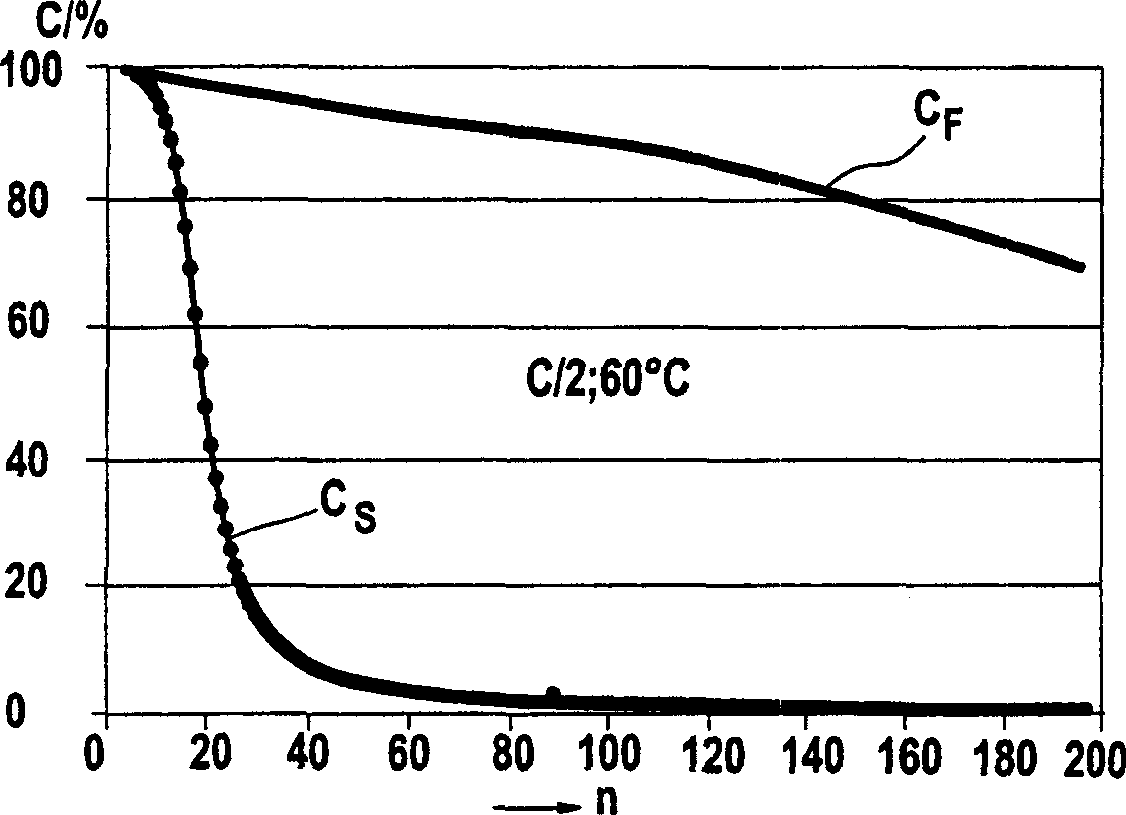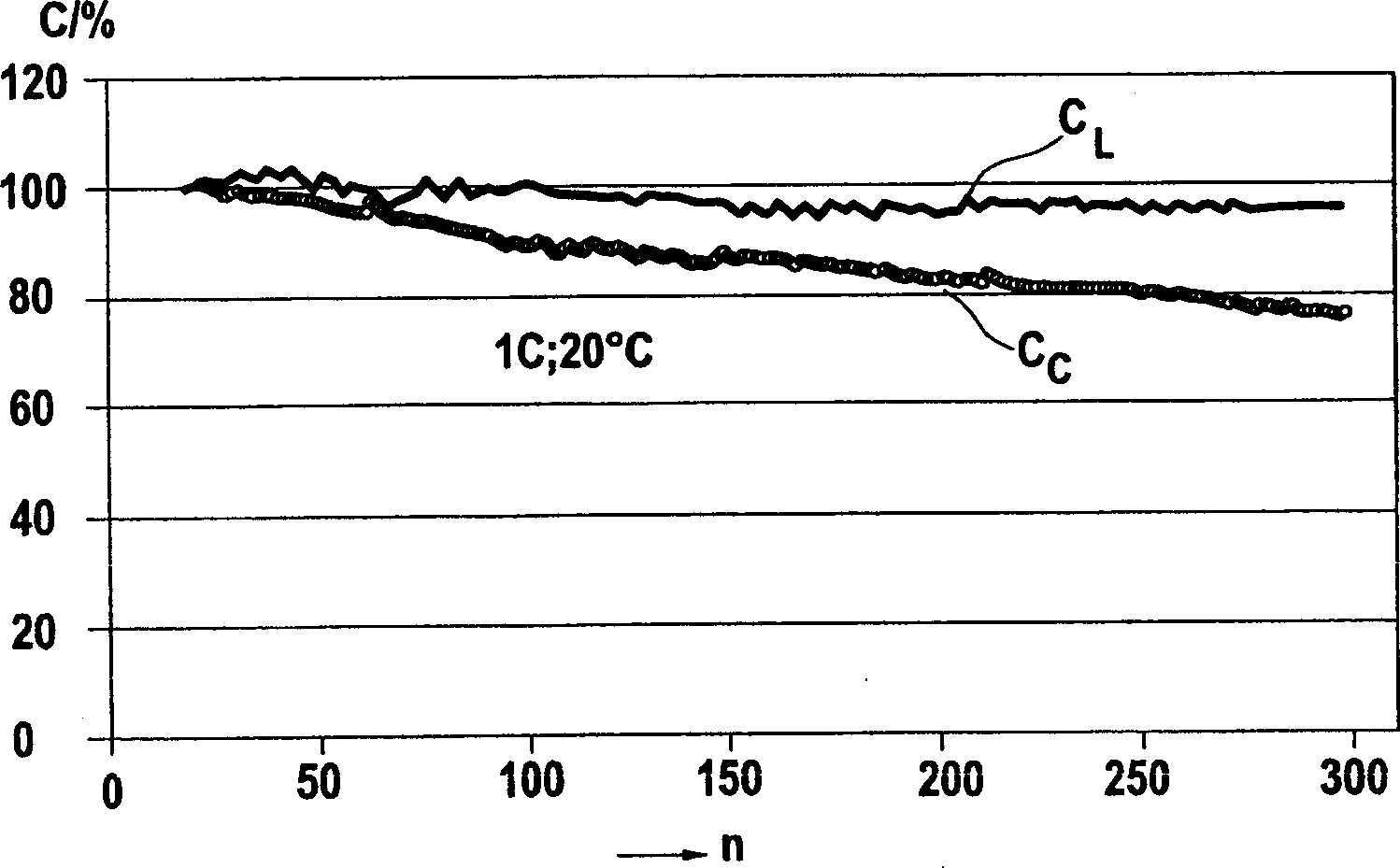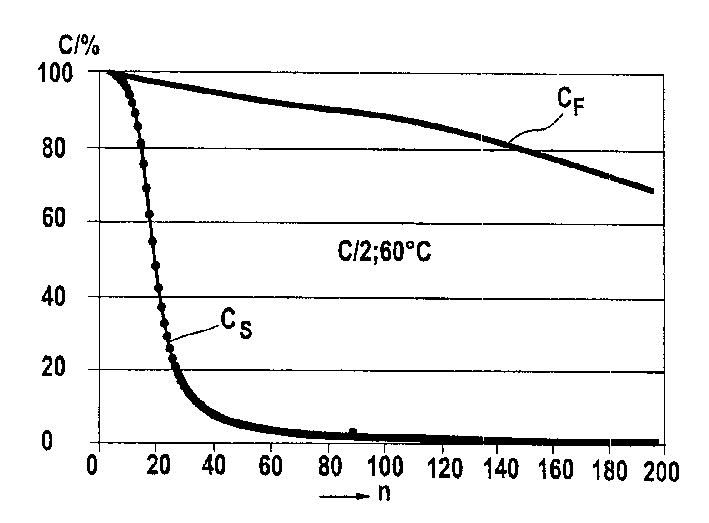Cell with at least one inlaid lithium electrode
A battery and electrode technology, applied in organic electrolyte batteries, non-aqueous electrolyte batteries, electrode carriers/collectors, etc., can solve the problems of expensive metal mesh, increased rolling pressure and annealing process, etc.
- Summary
- Abstract
- Description
- Claims
- Application Information
AI Technical Summary
Problems solved by technology
Method used
Image
Examples
Embodiment 1
[0025] To make the negative electrode, 250ml of acetone and 27.8g of PVDF-HFP (Powerflex, ElfAtochem Company) were put into a 500ml Erlenmeyer flask and heated to 42°C in a water bath. Stir with an IKA mixer until the polymer is completely dissolved. Then add 6.2g of conductive carbon black (SuperP, Sedema Company) and 275.3g of spherical graphite (MCMB 25-28, Osaka Gas Company) and stir for 2 hours, and adjust the number of revolutions (Drehstufe) to such an intensity that it does not stir in Air.
[0026] For the positive electrode, the same process method will be followed, here 24.8g PVDF-HFP (Powerflex, Elf Atochem Company), 2.6g conductive carbon black (Super P.Sedema Company), 2.6g graphite (KS 6 Timcal Company) are used as conductive The property modifier and 276.2g of lithium cobalt oxide (FMC) were added to 250ml of acetone.
[0027] Negative electrode and positive electrode are manufactured by cast-assisted belt method, and their surface weight is 19-21g / cm 2 . M...
Embodiment 2
[0031] The material for the negative electrode was prepared according to Example 1 and was applied directly to a Cu-conductor electrode surface-treated according to the invention (surface treatment by electrochemical deposition of copper crystallites) instead of on a polyester foil . The solvent was allowed to evaporate, and the electrode adhered well to the conductor electrode in the dry state. In this way, the preparation scheme is composed of one bicell instead of six bicells. Example 3:
Embodiment 3
[0032]To make the negative electrode, 1 liter of acetone was placed in a 2 liter Erlenmeyer flask together with 123.7 g of PVDF-HFP (Powerflex, Elf Atochem) and heated to 42° C. in a water bath. Stir with an IKA mixer until the polymer is completely dissolved. Then add 261.2g dibutyl phthalate, 27.5g conductive carbon black (Super P.Sedema company) and 962g spherical graphite (MCMB 25-28, Osaka Gas company) and stir 2 hours, the number of revolutions is adjusted to such intensity, Just enough not to stir in the air.
[0033] For the positive electrode, the same process method will be followed, where 99.0 g of PVDF-HFP (Powerflex, Elf Atochem Company), 165.1 g of dibutyl phthalate, 66.0 g of conductive carbon black (Super P , Sedema Company) as a conductivity modifier and 939.7g lithium cobalt oxide (FMC).
[0034] Negative electrode and positive electrode are manufactured by cast-assisted belt method, and their surface weight is 19-21g / cm 2 . Mylar (polyester foil) was use...
PUM
| Property | Measurement | Unit |
|---|---|---|
| size | aaaaa | aaaaa |
| thickness | aaaaa | aaaaa |
Abstract
Description
Claims
Application Information
 Login to View More
Login to View More - R&D
- Intellectual Property
- Life Sciences
- Materials
- Tech Scout
- Unparalleled Data Quality
- Higher Quality Content
- 60% Fewer Hallucinations
Browse by: Latest US Patents, China's latest patents, Technical Efficacy Thesaurus, Application Domain, Technology Topic, Popular Technical Reports.
© 2025 PatSnap. All rights reserved.Legal|Privacy policy|Modern Slavery Act Transparency Statement|Sitemap|About US| Contact US: help@patsnap.com



